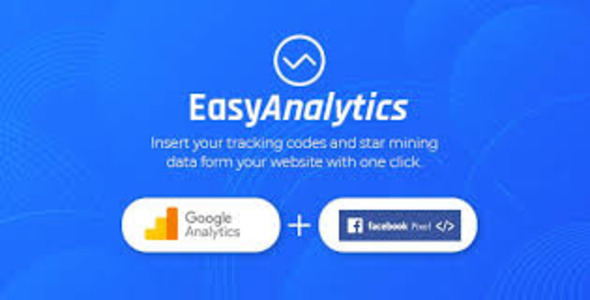Easy Analytics Tracking 1.0

70+ Reviews
with 5 star Ratings

99% Customer
Satisfaction

7-Days
Money Back
Request update for this product.
$15.00 Original price was: $15.00.$2.99Current price is: $2.99.
- Version: 1.0
- Last Updated: 26/12/2024
- License: GPL
- 1 year of updates & unlimited domain usage
- Updates Will Come With A 24-48h Delay
- Original product with the lowest price ever
- Downloaded from original authors
- Instant delivery & fast downloading speed
- 100% clean and tested code
- Get this Product for Free in Membership
In the digital world, data is a powerful tool that can drive better decision-making and improve performance. Understanding user behavior, tracking conversions, and measuring campaign effectiveness are crucial for any business or website. However, many businesses struggle with setting up and using analytics tools effectively. Fortunately, easy analytics tracking is the solution to simplify the process, providing you with the insights you need without overwhelming complexity.
In this article, we will explore what easy analytics tracking is, its benefits, and how you can implement it in your business strategy.
What is Easy Analytics Tracking?
Analytics tracking refers to the process of collecting, analyzing, and interpreting data about your website or business performance. Easy analytics tracking, as the name suggests, aims to simplify this process by making it user-friendly and accessible, even for those with little to no technical expertise.
While traditional analytics tools, such as Google Analytics, offer a wealth of information, they can be overwhelming for beginners. Easy analytics tracking tools are designed to provide clear, actionable insights with minimal setup and complexity. These tools allow businesses to track essential metrics such as website traffic, user interactions, conversion rates, and more, all from a simplified dashboard.
Benefits of Easy Analytics Tracking
1. Simplicity and User-Friendliness
One of the biggest challenges with traditional analytics tools is their complexity. Setting up custom reports, tracking events, and interpreting data can be difficult for non-technical users. Easy analytics tracking tools are designed with simplicity in mind, providing a clean and intuitive interface. Users can quickly set up tracking codes, view essential metrics, and make informed decisions with minimal effort.
2. Real-Time Insights
With easy analytics tracking, you can receive real-time updates on website performance, which is crucial for adapting your marketing strategies. For example, if you’re running a paid ad campaign, you can monitor its performance immediately and make adjustments if needed. Real-time tracking allows for more agile decision-making and ensures that you’re not flying blind in your marketing efforts.
3. Improved Conversion Tracking
Conversion tracking is essential for measuring the success of your marketing campaigns. Easy analytics tracking tools simplify this process by allowing you to easily set up and monitor conversion goals. Whether it’s a sale, lead generation form submission, or newsletter sign-up, these tools can track conversions and provide insights into what’s working and what’s not.
4. Cost-Effective
Many businesses shy away from analytics tracking because they assume it will be too expensive or time-consuming. Easy analytics tools are often more affordable than advanced platforms, making them accessible to businesses of all sizes. With a straightforward setup process, even small businesses can track their performance without needing to hire a team of data analysts.
5. Better Decision-Making
The ultimate benefit of analytics tracking is better decision-making. When you have access to clear and actionable data, you can make informed decisions about your marketing strategies, website design, and user experience. Easy analytics tracking removes the guesswork and ensures that every decision is based on real data.
How to Implement Easy Analytics Tracking
1. Choose the Right Analytics Tool
The first step in implementing easy analytics tracking is selecting the right tool for your business. There are several options available, each with its own features and benefits. Some popular easy-to-use tools include:
- Google Analytics: While it has a steep learning curve, Google Analytics can still be a powerful tool for those who are willing to invest the time. Many beginners opt for Google Analytics alternatives that are simpler, but it remains the most comprehensive.
- Matomo: An open-source analytics tool that is privacy-focused and offers a user-friendly interface.
- Piwik PRO: Another user-friendly analytics tool, Piwik PRO provides enterprise-level features while being intuitive and easy to use.
- Fathom Analytics: A privacy-focused, simple alternative to Google Analytics that offers clean dashboards and easy integration.
Consider factors such as pricing, integrations, ease of use, and the specific data insights you need when choosing your tool.
2. Set Up Tracking on Your Website
Once you’ve selected a tool, the next step is to set up tracking on your website. Most easy analytics tools provide a simple process for adding a tracking code to your website. This code is typically added to the header of each page, allowing the tool to monitor user behavior across your site.
Some tools also offer integration with website platforms such as WordPress, Shopify, and Wix, making the process even easier. For example, many WordPress themes include built-in support for Google Analytics, so you can connect your account with just a few clicks.
3. Define Key Metrics and Goals
To get the most out of your easy analytics tracking, it’s important to define what you’re tracking and why. Setting up goals and metrics is essential for understanding the effectiveness of your website and marketing strategies. Common metrics include:
- Pageviews: The number of times a page is viewed.
- Bounce Rate: The percentage of visitors who leave after viewing only one page.
- Average Session Duration: The average time users spend on your site.
- Conversion Rate: The percentage of visitors who complete a desired action, such as making a purchase or filling out a contact form.
By setting clear goals, such as increasing conversion rates or reducing bounce rates, you can use easy analytics tracking to measure progress and optimize your strategies.
4. Monitor and Analyze the Data
Once tracking is set up and goals are defined, the next step is to regularly monitor and analyze the data. Most easy analytics tracking tools provide a dashboard that displays key metrics in real-time. You can view graphs, charts, and tables that visualize your website’s performance.
When analyzing the data, look for patterns and trends that can inform your decisions. For example, if you notice a high bounce rate on a particular page, you may want to improve its content or design to keep visitors engaged.
5. Take Action Based on Insights
The ultimate goal of analytics tracking is to improve your business performance. By using the insights gained from your easy analytics tool, you can make data-driven decisions that lead to better results. Whether it’s adjusting your ad campaigns, improving website content, or optimizing the user experience, actionable insights allow you to fine-tune your strategies for maximum impact.
Common Mistakes to Avoid
While easy analytics tracking is designed to be user-friendly, there are still common mistakes businesses often make. Here are a few to avoid:
1. Not Defining Clear Goals
Without clear goals, you won’t be able to measure your success or determine the right metrics to track. Make sure your goals are specific, measurable, and aligned with your overall business objectives.
2. Ignoring Data Segmentation
Segmentation allows you to break down your data into meaningful categories, such as traffic sources or user demographics. Ignoring this feature can lead to a lack of insight into how different audience segments behave on your site.
3. Not Tracking Conversions
Tracking conversions is one of the most important aspects of analytics. Without conversion tracking, you won’t know if your efforts are driving the results you want. Set up conversion goals early on to ensure you’re measuring what matters.
4. Relying Too Much on Default Reports
Many easy analytics tools offer default reports, but they may not cover the full scope of your needs. Take the time to customize your reports to get more granular insights that are specific to your business.
Conclusion
Easy analytics tracking is an essential tool for businesses looking to make data-driven decisions without getting bogged down by technical complexities. By simplifying the tracking process, you can gain valuable insights into user behavior, optimize your website, and improve marketing performance.
With the right tool and a clear strategy in place, easy analytics tracking empowers businesses of all sizes to leverage data for better results. Whether you’re a small business owner or a marketing professional, mastering the art of easy analytics tracking is a game-changer for growth and success.
You must be logged in to post a review.




Reviews
Clear filtersThere are no reviews yet.